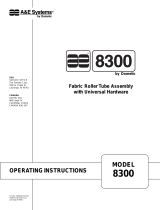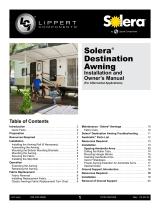
Read these instructions carefully. These
instructions MUST stay with this product.
USA
SERVICE OFFICE
Dometic Corporation
1120 North Main Street
Elkhart, IN 46514
CANADA
Dometic Corporation
46 Zatonski, Unit 3
Brantford, ON N3T 5L8
CANADA
SERVICE CENTER &
DEALER LOCATIONS
Please Visit:
www.eDometic.com
REVISION B
Form No. 3314494.000 09/16
(French 3314495.000_B)
©2016 Dometic Corporation
LaGrange, IN 46761
TYPE
9500
MANUAL
CASE / CASSETTE AWNING
MODEL
200(LL)(CC).003(#)
RECORD THIS INFORMATION FOR FUTURE
REFERENCE:
Model Number
Serial Number
Date Purchased
Retailer / Qualied Installer
OPERATING
INSTRUCTIONS

2
TABLE OF CONTENTS
INTRODUCTION ....................................................................................................................................................................2
DOCUMENT SYMBOLS ........................................................................................................................................................2
IMPORTANT SAFETY INSTRUCTIONS ................................................................................................................................ 3
A. Recognize Safety Information ...................................................................................................................................3
B. Understand Signal Words ..........................................................................................................................................3
C. Supplemental Directives ............................................................................................................................................ 3
D. General Safety Messages .........................................................................................................................................3
OPERATION ...........................................................................................................................................................................4
A. Open Awning .............................................................................................................................................................4
B. Water Shed Feature ..................................................................................................................................................5
C. Close Awning .............................................................................................................................................................5
D. Prepare Awning For Travel ........................................................................................................................................5
GENERAL CARE AND USE ...................................................................................................................................................6
A. Precautions ................................................................................................................................................................6
B. Hardware Maintenance .............................................................................................................................................6
C. Fabric Maintenance ...................................................................................................................................................6
D. When To Get More Help ............................................................................................................................................6
INTRODUCTION
This cassette awning (hereinafter referred to as “awning,” or “product”) is designed and intended for use on RVs with straight
sides. It is especially well suited for RVs with an over cab extension where there is not sufcient surface for a bottom mount-
ing bracket. Use these instructions to ensure correct operation of product.
Dometic Corporation reserves the right to modify appearances and specications without notice.
DOCUMENT SYMBOLS
Indicates additional information that is NOT related
to physical injury.
Indicates step-by-step instructions.

3
IMPORTANT SAFETY INSTRUCTIONS
This manual has safety information and instructions to help
you eliminate or reduce the risk of accidents and injuries.
A. Recognize Safety Information
This is the safety alert symbol. It is used to
alert you to potential physical injury hazards.
Obey all safety messages that follow this
symbol to avoid possible injury or death.
B. Understand Signal Words
A signal word will identify safety messages and
property damage messages, and will indicate the
degree or level of hazard seriousness.
indicates a hazardous situation that,
if NOT avoided, could result in death or serious in-
jury.
indicates a hazardous situation that,
if NOT avoided, could result in minor or moderate
injury.
is used to address practices NOT
related to physical injury.
C. Supplemental Directives
Read and follow all safety information and
instructions to avoid possible injury or death.
Read and understand these instructions be-
fore [installing / using / servicing / performing
maintenance on] this product.
Incorrect [installation / operation / servicing /
maintaining] of this product can lead to seri-
ous injury. Follow all instructions.
The installation MUST comply with all ap-
plicable local and national codes, including
the latest edition of the following standards:
U.S.A.
● ANSI/NFPA70, National Electrical Code
(NEC)
● ANSI/NFPA 1192, Recreational Vehicles
Code
CANADA
● CSA C22.1, Parts l & ll, Canadian Electri-
cal Code
● CSA Z240 RV Series, Recreational
Vehicles
D. General Safety Messages
Failure to obey the following warn-
ings could result in death or serious injury:
● This product MUST be [installed / serviced] by a
qualied service technician.
● Do NOT modify this product in any way. Modica-
tion can be extremely hazardous.
● Frequently examine product for imbalance (un-
even t / sagging / loose parts); and signs of wear
or damage to wiring (if applicable) and other criti-
cal parts. Do NOT use product if adjustments or
repairs are necessary.
Critical parts may include awning fabric,
cables, arm assemblies, etc.
● Do NOT allow anyone (including children) with
reduced physical, sensory or mental capabilities,
or lack of experience and knowledge to use this
product, unless they have been given supervision
or instruction (concerning use of this product) by
a person responsible for their safety.
● Do NOT allow children to play with product or with
xed controls (if applicable).
● Do NOT add any devices or accessories to this
product except those specically authorized in
writing by Dometic Corporation.
● IMPACT OR CRUSH HAZARD. NEVER leave an
open awning unattended. Keep awning stowed
(closed) when snow, heavy rain, wind, and severe
weather conditions are expected.
● IMPACT OR CRUSH HAZARD. Do NOT allow
water to pool, snow to accumulate, or heavy
debris on awning fabric. Do NOT hang or place
anything on awning. The awning will become
unstable, and could bend or collapse.
● FIRE HAZARD. Keep sources of heat and re
(barbecue grills, portable heater, etc.) away from
awning.
Failure to obey the following cau-
tions could result in injury:
● PINCH HAZARD. Maintain a horizontal distance
of at least 16″ between fully open awning and any
permanent object.
Do NOT face awning toward permanent
objects that may interfere with awning op-
eration.

4
A. Open Awning
1. PINCH HAZARD. Maintain a
horizontal distance of at least 16″ between fully
open awning and any permanent object. Failure
to obey this caution could result in injury.
Place hook end of hand crank into gear’s eye.
Then rotate hand crank until awning is fully ex-
tended. See (FIG. 1).
The awning is fully extended when fabric
starts to sag. See (FIG. 2).
FIG. 1
Gear’s Eye
Hand Crank
FIG. 2
Sagging Fabric
Fabric Edge
2. Do NOT allow awning fabric to
rest on rafters. Wind will cause awning fabric to
rub against arm assemblies which could result in
premature wear and abrasions.
When awning is fully extended (fabric is sag-
ging), rotate hand crank back approximately 1/4
turn to obtain maximum tension. See (FIG. 3).
FIG. 3
Taut Fabric
Lateral Arm
Assembly
Fabric Edge
OPERATION

5
D. Prepare Awning For Travel
1. IMPACT OR CRUSH HAZARD.
Do NOT transport RV if awning fabric is torn /
damaged, even if awning closes successfully.
Damaged awning fabric could compromise aw-
ning’s stability, and could allow awning to extend
quickly and unexpectedly during transit. Failure
to obey this warning could result in death or seri-
ous injury.
Inspect Awning for damage.
If awning fabric is torn / damaged, tie all
lateral arm assemblies securely (with fab-
ric strapping or light rope) near shoulder
and wrist to close awning as much as pos-
sible. Then contact a qualied Dometic
service technician for on-site repair. See
(FIG. 5).
FIG. 5
Lateral Arm Assembly
Near Shoulder
Assembly
Near Wrist Assembly
B. Water Shed Feature
Failure to obey the following warn-
ings could result in death or serious injury:
● IMPACT OR CRUSH HAZARD. Do NOT allow
water to pool or snow to accumulate on awning
fabric. The awning will become unstable, and
could bend or collapse. Whenever heavy rain
or snow is expected, place awning in stowed
(closed) position.
● IMPACT OR CRUSH HAZARD. Do NOT con-
strain or tie down lead rail as this could disable
the water shed feature.
This awning is designed with a water shed feature
that automatically lowers one side of awning during
light rain to allow water run off.
This water shed feature is meant for light rain
only.
FIG. 4
Lead Rail
C. Close Awning
PINCH HAZARD. Keep CLEAR
of arm assemblies while closing awning. Arm
assemblies will [fold / close] against back rail.
Failure to obey this warning could result in death
or serious injury.
Place hook end of hand crank into gear’s eye.
Then rotate crank until awning is fully retracted.
See (FIG. 1).
OPERATION

6
A. Precautions
Failure to obey the following notices
could damage product or property:
● Do NOT use insecticides or other sprays near aw-
ning fabric. These could cause stains, and could
adversely affect fabric’s ability to repel water.
● Do NOT expose awning to adverse environmental
conditions, corrosive agents, or other harmful
conditions.
● Do NOT allow corner of entry door to contact aw-
ning fabric. Otherwise, premature wear or tearing
of awning fabric could occur.
● NEVER close awning (for storage) when wet. The
combination of moisture and dirt could result in
mildew, discoloration, and stains.
If it is necessary to roll up awning (tem-
porarily) while it’s wet, make sure you roll
it out and let it dry (as soon as conditions
allow) before rolling it up again.
● Do NOT allow dirt, leaves, or other debris to ac-
cumulate on awning, which could cause abrasion
and stains. Mildew could grow on dirt and organic
debris causing permanent discoloration, stains,
and odors to awning fabric.
B. Hardware Maintenance
1. Do NOT use strong chemicals or
abrasives to clean parts, as their protective sur-
faces will be damaged.
Clean awning hardware (as needed) with a mild
surface cleaner (such as dish soap).
2. Do NOT use silicone sprays near
labels. Otherwise, the label’s adhesive bond to
product surfaces could weaken.
Apply silicone spray lubricant as needed to keep
the fabric roller tube assembly’s moving parts
operating smoothly.
3. Lubricate all sliding surfaces of arm assemblies
with silicone spray as needed.
C. Fabric Maintenance
Vinyl fabric offers the advantage of durability and
water resistance.
Wrinkling is a normal characteristic of vinyl.
Wrinkling may be more noticeable when re-
tracted, and after prolonged periods of stow-
age (rolled up). Leave awning open during
warm weather to minimize the wrinkling over
a period of time.
1. To clean:
a. Mix 1/4 cup dish soap and 1/4 cup bleach to
5 gallons of fresh water to use as cleaning
solution.
b. Do NOT use abrasive or cor-
rosive cleaners, mildew removers, or hard
bristle brushes on awning fabric.
Liberally drench open awning fabric with
cleaning solution.
c. Close awning, let it soak for 5 minutes, then
open awning again.
d. Remove solution COM-
PLETELY from awning fabric. Bleach will
degrade awning fabric if NOT completely
rinsed off.
Thoroughly hose off top and bottom of fabric
with clean water.
Repeat as necessary to completely re-
move solution.
e. NEVER close awning (for
storage) when wet. The combination of
moisture and dirt could result in mildew, dis-
coloration, and stains.
Allow awning to dry thoroughly before stow-
ing (rolling up).
2. To repair a pinhole, or if a spot of coating akes
off from top layer of vinyl fabric:
a. Apply a very small dab of VLP (Vinyl Liquid
Patch) on tip of cotton swab.
VLP is available from Dometic Cor-
poration. Reference part number
3314216.000 when ordering.
b. Gently roll cotton swab around pinhole. The
VLP will melt the coating (on fabric) and that
will quickly ll in pinhole and blend with all
colored vinyls.
c. NEVER close (roll up) awning
when vinyl liquid patch is wet. Otherwise,
damage to other parts of awning fabric (melt-
ing through layers) will occur.
Allow VLP to dry thoroughly before stowing
(rolling up) awning.
D. When To Get More Help
If malfunctions occur (that cannot be corrected by
reviewing these instructions), contact a qualied
service technician.
A slight “travel line” may appear where door
roller (if installed) contacts awning fabric.
This is considered normal and does NOT af-
fect the integrity of awning fabric.
GENERAL CARE AND USE
/





